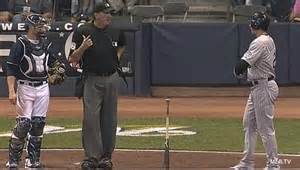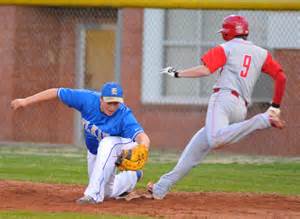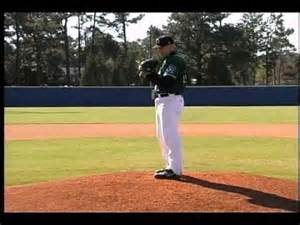Clarifying Baseball Rumors:
Baseball Rumors and myths, pertaining to rarely encountered called plays, will still pop up several times a year, especially if you play a heavy schedule. It doesn’t matter whether you’re an experienced coach or a newbie, when it comes to being involved in a controversial play, because the interpretation and call will be made by the umpire, and if he gets it wrong, it may cost you the ballgame.
It may be quite beneficial to copy these, or at least memorize, these most common misconstrued rumors & myths pertaining to plays and what the rule book actually states.
1. The baseball is immediately called a Dead Ball on a foul tip. Younger umpires blow this one at an alarming rate.
Rule Book Rule 6.06(b,1) Foul-Tip Strike If the baseball nicks the bat and goes sharp and direct to the catcher’s hand or glove and is caught, this is a foul tip. A foul tip is a strike and the ball is alive.

Foul Tip? Baseball Rumors:
If the ball is Not caught, it is declared a foul ball. If the nicked pitch first hits the catcher somewhere else other than the glove or hand, it is Not a foul tip, but a Foul Ball and … The ball is considered dead.
2. No run can score when a runner is called out for the third out for failing to tag up. In my opinion, this is a very confusing rule and mis - interpretation is not unusual. Clarifying Baseball Rumors:
Rule Book Rule 2.00 Force Play, 4.09, 7.10(a) This is Not considered a Force Play, therefore runs can be scored. Definition of a force play is when a runner is forced to advance because the batter became a runner.
Example: a runner on first being forced out at second on a ground ball hit by the batter, who is now a runner attempting to occupy first base. Baseball Rumors:
When the batter is declared out because the fly ball is caught, all force outs are removed. Example: batter hits pop fly on the infield which is caught for an out. The runner on first base is not required to advance because the batter is out, therefore can not be forced out.
An out on a failure to tag-up is not a force out, therefore any runs which crossed the plate before this out being declared will count.
Example: Bases loaded, fly ball caught in center field. As the Runners tag and advance, the throw back into the infield goes wild and the runner on second base also scores.
The offense appeals that the original runner on third base left too soon, not properly tagging up, and is declared out by the umpire. Although this constitutes the 3rd out, the runner that scored from second base … that run counts.
I told you it was confusing.
3. Tie goes to the Runner.
Rule: Believe it or not .. There is No such rule. A runner is either Out or Safe. There is no such thing as a Tie in the rule book.
4. Should a batter bat out of order, the official batting order given the umpire and opposing team, that batter is declared out. For example batter number 7 hits before batter number 6.
Rule: The Proper batter is declared out. In other words, batter 6, even though he did not bat, will be declared out. If that out does not end the inning, batter 7 who just batted, but out of turn, bats again. Baseball Rumors:

Safe or Out .. No Tie Baseball Rumors:
Should any base runners advanced due to a hit, walk, error or any other reason resulted from the wrong batter, the results will be nullified and returned to positions prior to the infraction.
Example: The wrong batter walked, which forced the runner on first to second base. The runner would be required to return to first base.
5. The baseball is declared dead anytime an umpire is hit by the ball, whether hit or thrown.
Rule: 2.00 Interference 5.09(b), 5.09(f) The ruling on this situation is - Depends. If an umpire is hit by a batted ball Before it passes a fielder … the ball is dead.
Example: The umpire is stationed between the pitching mound and second base and a batted ball hits the umpire before it has gotten passed the shortstop or second baseman .. The baseball is declared Dead.
The batter is awarded first base and should that create a forced advancement of other runners, they advance 1 base.
Any other baseball, hit or thrown and hits the umpire, the ball is Alive. Example: The catcher throws to first in a pick off attempt, the first baseman misses the ball and it hits the umpire, careening into right field. The ball is alive and runners may advance at their own risk, as far as they chose.
6. If a fielder catches a fly ball and then falls over the fence … it’s a home run or out of play ball if in foul territory. Baseball Rumors:
Rule: 2.00 Catch, 6.05(a), 7.04(c) If the fielder is not in dead ball territory when he catches the ball, it is a legal catch and considered an Out.
In other words, a player catches a foul ball fly, then falls into the stands, it is considered a legal catch and the batter is out. However, if the fielder for example, has 1 foot on the dugout steps when he catches the ball, it is Not a catch, because the fielder has part of his body in dead ball territory.

Pick Off? Baseball Rumors:
It is not a Home Run, but an Out.
7. The batter is declared out if a bunted ball hits the ground and bounces back up, hitting the bat a second time, while the batter is still holding the bat.
Believe it or not, this is not real unusual in lower aged leagues where the players have limited experience bunting and getting out of the box.
Rules: 6.05(h) & 7.09(b) The rule says the bat can not hit the ball twice. Therefore, if the ball bounces and hits the bat a second time, it’s declared a Dead Ball and is considered a foul ball strike, unless the event occurs on what would be the third strike, then the batter is declared out.
8. The hands are considered part of the bat, therefore if a player is hit on the hand while batting, it is a foul ball.
Answer: Again…. It depends. To begin with, let’s clarify the hands are part of the player’s body, not the bat. Number one, If a pitched ball hits the player’s hand, the ball is declared dead.
If the batter was swinging at the pitch when struck, the pitch is considered a strike, Not a foul ball. This is an important difference, because if it occurs on the third strike, the batter is declared out as if he swung and missed, not fouled the ball.
If the player is hit while trying to avoid the ball, the ball is declared dead and the runner is awarded 1st base. Should there be a runner on 1st, he advances 1 base, as every other runner would if the base is occupied. Baseball Rumors
9. The pitcher must come to a set position before he can make a pick off attempt.
Answer: This is almost a trick question if you don‘t pay attention. The pitcher must come to a complete stop, or concernable pause, at the set position before he can Pitch, (throw to the plate) Not to make a pick off throw.
*** Not stopping at the set position constitutes a balk.***
10. The batter Must turn to the right after over-running first base, or else can be tagged out.
Rule: 7.08(c & j) The batter, turned runner, may turn left or right after over-running 1st base as long as the runner makes No attempt to advance to second base. The definition of attempt is the umpire’s judgment.
This situation hits a personal nerve. I had a player called out for turning to the left although he returned directly to 1st base. Turns out this would have been the kid’s ONLY hit of the year, but a young umpire called him out because he turned to the left.
Had the umpire said in his opinion the runner offered an attempt to advance, I would have shut up immediately, although I would not have agreed. However, the umpire’s position was the runner turned left - therefore was out.
Obviously, this is but a small sampling of myths & rumors concerning the rules which can create heartburn for a coach. Attempt to know the rules, calmly state your case and good luck.
Baseball Rumors To Coaching Skills
Learn Youth Baseball Coaching

New! Comments
Have your say about what you just read! Leave me a comment in the box below.